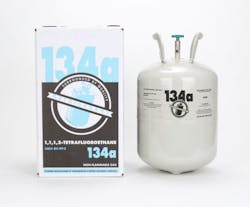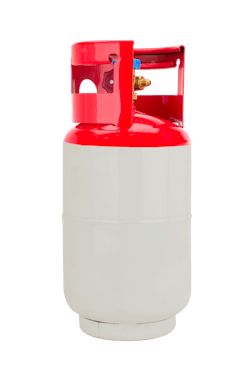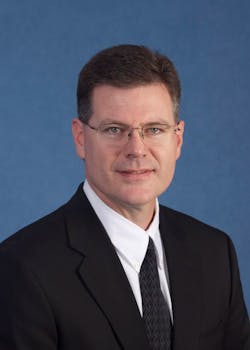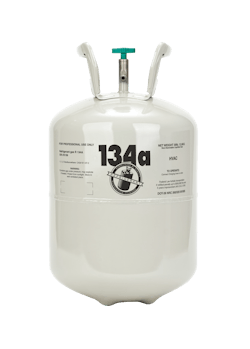AIM Act Blowback: Worthington Ind. Targets Ban on Non-refillable Refrigerant Cylinders
From press release, with additional reporting by Terry McIver.
COLUMBUS, Ohio, November 10, 2021 -- Worthington Industries, Inc., the last remaining U.S. manufacturer of steel refrigerant cylinders for the HVACR industry, announced on November 10 that it has filed a petition for partial administrative reconsideration with the Environmental Protection Agency (EPA). The petition asks the agency to rescind the ban on non-refillable cylinders, which was included as part of its Final Rule to implement the American Innovation and Manufacturing (AIM) Act.
The AIM Act, signed into law in late 2020, was aimed solely at phasing down the production and consumption of specific hydrofluorocarbons (HFCs).
“We hope the EPA will accept our petition, rescind the ban and work with us to employ Worthington’s innovative solutions to address the agency’s concerns about smuggling and heel emissions.” Rose continued, “Supporting the petition will help restore the important balance achieved in the AIM Act to address climate change and support American manufacturing.”
Solution Offered
Worthington’s petition includes as a solution an updated, fully recyclable, lightweight cylinder that adds environmental safety technology to address venting issues and will deter smuggling of banned substances through reliance on domestic production capacity. Worthington says its alternatives will help keep American jobs in America, protect the environment, prioritize HVAC workers andWorthington Industries claimes the EPA did not address concerns submitted to the agency demonstrating the ban’s infeasibility and direct harm to HVAC technicians.
On Oct. 5, 2021, EPA posted a final rule Phasedown of Hydrofluorocarbons: Establishing the Allowance Allocation and Trading Program Under the AIM Act that included a ban on non-refillable cylinders. The final rule effectively prohibits the sale of this cylinder as of December 31, 2024 which is produced in Columbus, Ohio, and Paducah, Kentucky, by 500 American workers.
No EPA Authority to Ban
Worthington strongly opposes the ban on non-refillable cylinders, and contends the AIM Act provides no explicit legal authority to the EPA to implement the ban, adding that the EPA did not address concerns submitted to the agency demonstrating the ban’s infeasibility and direct harm to HVAC technicians who often work in elevated, cramped spaces and because of the ban, will be forced to carry cylinders that are four times heavier, likely increasing injuries.
EPA rationalized the cylinder ban in its rule based on:
1) Preventing HFC gas venting and leakage; and
2) The ease of identifying the cylinder to keep out illegal HFC imports.
Worthington Industries says it shares those concerns, however, short of an outright ban on the cylinder, Worthington has developed a much simpler solution to address these issues, which is the basis for the petition.
Wayne Powers, director of refrigerants for Worthington Industries, in an interview with Contracting Business, echoed Mr. Rose's support for the AIM Act, adding that the refrigerant industry itself is largely supportive of the AIM Act and its 15-year plan to reduce HFC refrigerants."Most recognize that is for the benefit of the overall environment," Powers said. "I think where it comes to points of challenge, is that our customer base of producers and distributors has been almost solely focused on the refrigerant allocations, because it is so critical to their businesses. They have to get the allocations of refrigerant production and sale and distribution correct, because it will impact their business models for the next 15 years. It’s left Worthington as one of the few entities focused on actually addressing the heart of the implementation of the AIM Act, which is solely focused on the ban on the non-refillable cylinder, which is the current vessel of choice for the packaging and distribution of these gasses. Most are focused on allocations, whereby Worthington is trying to focus on this piece, the package itself," Powers said.
EPA's Flawed Assumptions
Powers continued to say he feels the Environmental Protection Industry's actions are based on a mischaracterization of contractor's handling of refrigerants in the field and misunderstanding of the"Their assumptions are that refrigeration contracting professionals don’t properly recycle the cylinders and reclaim gasses. We contend that these professionals do largely handle those correctly today. There is also a flawed assumption as to the actual venting of emissions in terms of what the residual content inside a cylinder might be at the end of cylinder life. The EPA contends that 5% or more [of the gas inside an empty cylinder] could make its way into the atmosphere. However, the residual in those cylinders, as found by the California Air Resources Board (CARB) and others that have done studies, is that it’s much less than the EPA assumption [of 5%]."
Non-refillable Cylinder Benefits
"The current, non-refillable cylinder essentially makes a one-way trip," Powers says. "It’s filled at the refrigerant producers, then sold to the wholesalers who actually supply the refrigerant contractors. At its end of life, those contractors will return an empty, non-refillable cylinders to the wholesalers, where is when it will be put on its path to recycling or disposal.
"With the refillable route, the cylinder would have to be returned, cleaned, refurbished, repainted and supplied back to the producer to begin the process again. It involves much handling and transportation."
Preventing Venting
One of the assumptions EPA had was that the gasses were illegally vented into the atmosphere. A valve could be opened deliberately and gas vented into the atmosphere.
"That valve can be opened in the manner described," acknowledges Powers, "however, Worthington has proposed alternatives to that valve that exist in other areas of business that could help control that venting, without banning the cylinder.
"We were suggesting that we’re building to a specification, but it would be far more economically affective to modify that specification and continue to use the exiting cylinder. Another element EPA noted was the pressure release valve/device. The current design under DOT-39 specs is called a burst disc. Once it’s opened under a pressure event (say in a fire or other heat-related event) it would vent the contents of that cylinder. We proposed other pressure-relief devices that are used in other industries. We manufacture such cylinders today. They have spring-loaded relief devices that can actually reseat or reseal themselves, so they can relieve pressure and then reseal, to retain the remainder of the contents, keeping them from being released into atmosphere."
Powers continues: we are producing these in accordance with the specification, but minor modifications to the specification would provide a cylinder that doesn’t allow what they reference as leakage. The cylinders themselves do not leak. We pressure test every cylinder. What we have is just a couple of design modifications that would still be in compliance with the specificaions, yet handle the concerns in a far more economical fashion," Powers says.
Enforcement Issue
The Environmental Protection Industry's concern, as Powers describes it, is that by eliminating the existing non-refillable cylinder -- which has a distinctive design -- and moving to a non-refillable design, it would be easier to identify a refillable cylinder at the US border, in the fight against counterfeiting.
"Then [according to the EPA], you would be able to identify a non-refillable that came into the United States from another country. It would be easy to identify that cylinder. Our point of contention is, that belief is based on an action that was undertaken in Europe, when the European Union stopped the use of non-refillable cylinders in 2007. But that didn't stop the influx of illegal imported gasses into Europe either. In fact, if anything, it caused an influx of low-quality, leaking, refillable cylinders from foreign entities that ultimately became the new, non-refillable cylinders. And these refillable cylinders that started to make their way in with illegal gasses made their way into landfills in the European market, and they continue to do so today. So, our point of contention was that this is not a cylinder problem, it’s more of an enforcement issue. If you change the vessel, foreign suppliers of illegal refrigerants will simply put it into the vessel that is accepted."
HARDI, ACCA, PHCC Join the Fight
And now, Worthington Industries is not alone in contesting this ban. On December 2, Heating, Air-conditioning & Refrigeration Distributors International (HARDI) filed a petition for judicial review in the United States Court of Appeals for the District of Columbia against the Environmental Protection Agency (EPA). The petition asks the court to overturn the ban on single-use cylinders and cylinder tracking requirements contained in the recently finalized rule, Phasedown of Hydrofluorocarbons: Establishing the Allowance Allocation and Trading Program under the AIM Act. HARDI is joined in the petition by Air Conditioning Contractors of America (ACCA), and Plumbing-Heating Cooling Contractors—National Association (PHCC). Read more HERE.
About the Author
Terry McIver
Content Director - CB
As director of content for Contracting Business, he produces daily content and feature articles for CB's 38,000 print subscribers and many more Internet visitors. He has written hundreds, if not two or three, pieces of news, features and contractor profile articles for CB's audience of quality HVACR contractors. He can also be found covering HVACR industry events or visiting with manufacturers and contractors. He also has significant experience in trade show planning.




